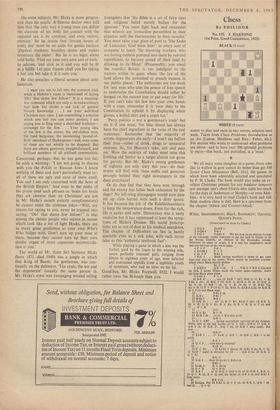Chess
By PHILIDOR No. 155. J. HARTONG (1st Prize, Good Companions, 1922)
BLACK (8 men) WHITE (8 men) WHITE to play and mate in two moves; solution next week. Taken from Chess Problems: Introduction to an Art (Lipton, Matthews and Rice: Faber, 42s.). For anyone who wants to understand what problems are about—and to have over 300 splendid problems to enjoy—this book, just published, is a 'must.'
We all enjoy some slaughter in a game; those who like to wallow in gore cannot do better than get 100 Soviet Chess Miniatures (Bell, 21s.), the games in which have been admirably selected and annotated by P. H. Clarke. The book would also make an ex- cellent Christmas present for any laudator temporis acti amongst one's chess friends who sighs too much for the days of Andersson or Morphy—or even Alek- hine: it is very hard to read Clarke's book and still think modern chess is dull. Here is a specimen from the chapter 'Attack and Counter-Attack.'
White, SHAPOSHNIKOV; Black, BAgrancov; Opening, QUEEN'S PAWN.
Notes based on those by Clarke.] K
1 P-Q 4 Kt-KB 3 32
P-B 4
P-QKt 4 We are•now In an obscure by-way .-Q 4
of the openings, totally unknown to me but said by Clarke to be the Wolga Gambit, an offshoot of the Hromadka system. Whatever its name or origin, it is a bad but imaginative move that sets the tone of the whole game. 4 PXP P-K 3 5 Kt-QB 3 PXP 6 Kt X P B-Kt 2 7 P-K 4 . .. Black having sacrificed a pawn to get open
lines and play In the centre. White makes an excellent counter- attack which Black should decline. 7 . . . Kt X P 8 B-KB 4 Q-R 4 ch. 8 . P-0 3; 9 B-B 4 followed by Q-K 2 leaves White much the beiter game—anyway, that's not how Black plays chess.
9 P-Kt 4 PXP
10 B-B 4! . . . . not 10 Kt-B 7 ch?. K-Q 1; 11 Kt X R P-Kt 6 chi; 12 B-Q 2 (12 K-K 2, Kt-B 6 ch or 12 Q-Q 2, Kt X Q; 13 B-B 7 ch. Q X B; 14 Kt X Q. P-Kt 71). Kt X B; 13 P X P (13 Q X Kt. B-Kt 5), Kt-B 6 d.ch; 14 K-K 2, Q X P ch and Black wins. 10 . PP:KKtt 76 ch 11
12 R-Kt I 13-Q 3
13 0-Q 41 . . . not 13 B X B?, Kt-Q 7 chi; 14 K-K 2 Kt X R; 15 Q X Kt, B X Kt; 16 B X B, 40 X P ch and 17 . . Q X B.
13 . 0-0 14 Qx1(4 BXB 15 Kt-K 7 ch ... 15 Q X B Is also good. -R
16 0 X KB? . . K . having successfully survived all his danget‘. White falls at the last hurdle: 16 Q X OBI, Q-B 6: 17 Q-K 4. Q-B 8 ch; 18 K-K 21, Q-Q 7 ch; 19 K.113 wins easily. But now ..
61
ld767:1. Kt-B Q-Bi 3 , . . 17 Kt-K 2, Q-B 7. 18 Q-B 5, B-K 5 Is R-K 1
18 Q X P ... now who Is winning?
18.. . 10-R 31 . 19 P X Kt . . . 19 Kt-Kt 5 (threat 20 Q-Kt 8 ch, R X 0: 21 Kt-B 7 mate) is defeated by 19 . . . Q-B 8 ch; 20 K-K 2, X Kt.
B
19 . . . -K 51 20 K-K 2 ... Now 2t0 3Kt-Kt 5, B-Q 6 ch 20 ' 21 kt-iCt 5 R X Kt ch
Q X B ch
22 QXR
23 K-B 3 .. or 23 K-0 2, Q-Q 6 ch or 23 K-K 3, R-K 1: w24QcaXR. ch. 'B X 0: and the threat of Q-11 6 ch and B-Kt 3
wins easily.
B-R 4 ch 24 23 Resigns. For 24 P-Kt 4, 40 X P ch; 25 K-K 3, Q-K 7 ch and 26 X Q.






































 Previous page
Previous page